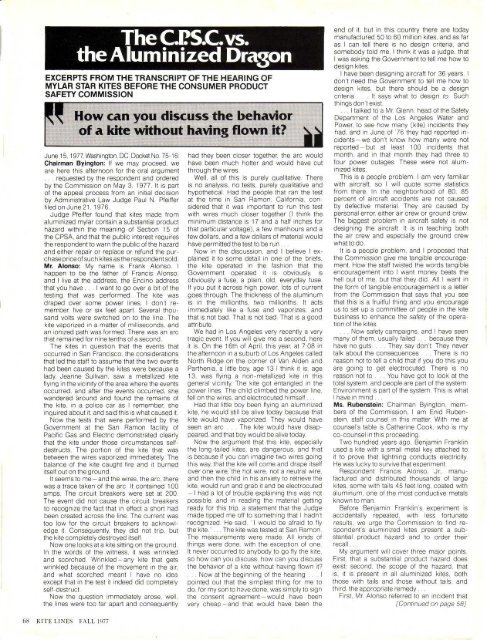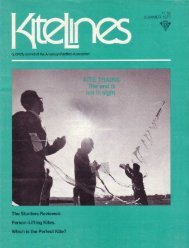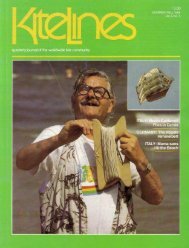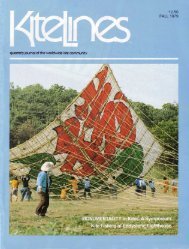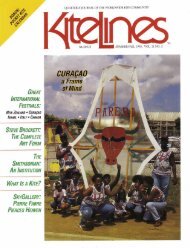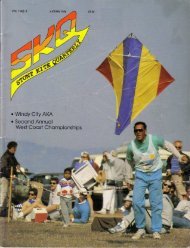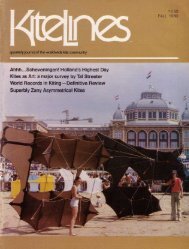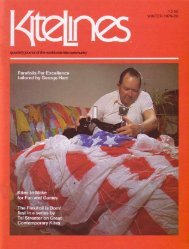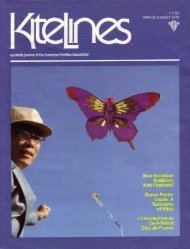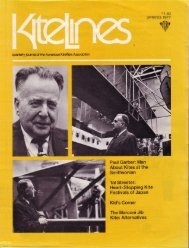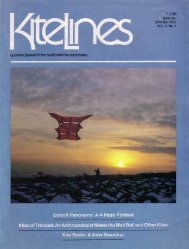You also want an ePaper? Increase the reach of your titles
YUMPU automatically turns print PDFs into web optimized ePapers that Google loves.
The C.P.S.C. vs .the Aluminized DragonEXCERPTS FROM THE TRANSCRIPT OF THE HEARING OFMYLAR STAR KITES BEFORE THE CONSUMER PRODUCTSAFETY COMMISSIONHow can your discuss the behaviorof a kite without having flown t'?June 15, 1977, Washington, DC . Docket <strong>No</strong> . 75-16 :Chairman Byington : If we may proceed, weare here this afternoon for the oral argument. . . requested by the respondent and orderedby the Commission on May 3, 1977 . It is partof the appeal process from an initial decisionby Administrative Law Judge Paul N . Pfeifferfiled on June 21, 1976 .Judge Pfeiffer found that kites made fromaluminized mylar contain a substantial producthazard within the meaning of Section 15 ofthe CPSA, and that the public interest requiresthe respondent to warn the public of the hazardand either repair or replace or refund the purchaseprice of such kites as the respondent sold .Mr. Alonso : My name is Frank Alonso . Ihappen to be the father of Francis Alonso,and I live at the address, the Encino addressthat you have . . I want to go over a bit of thetesting that was performed The kite wasdraped over some power lines, I don't re- member . five or six feet apart Several thousandvolts were switched on to the line . Thekite vaporized in a matter of milliseconds, andan ionized path was formed . There was an arcthat remained for nine tenths of a second .The kites in question that the events thatoccurred in San Francisco, the considerationsthat led the staff to assume that the two eventshad been caused by the kites were because alady, Jeanne Sullivan, saw a metallized kiteflying in the vicinity of the area where the eventsoccurred, and after the events occurred, shewandered around and found the remains ofthe kite, in a police car as I remember, sheinquired about it, and said this is what caused it .<strong>No</strong>w the tests that were performed by theGovernment at the San Ramon facility ofPacific Gas and Electric demonstrated clearlythat the kite under those circumstances selfdestructs. The portion of the kite that wasbetween the wires vaporized immediately . Thebalance of the kite caught fire and it burneditself out on the ground .It seems to me-and the wires, the arc, therewas a trace taken of the arc . It contained 100amps . The circuit breakers were set at 200 .The event did not cause the circuit breakersto recognize the fact that in effect a short hadbeen created across the line . The current wastoo low for the circuit breakers to acknowledgeit, Consequently they did not trip, butthe kite completely destroyed itself .<strong>No</strong>w one looks at a kite sitting on the ground .In the words of the witness, it was wrinkledand scorched . Wrinkled-any kite that getswrinkled because of the movement in the air,and what scorched meant I have no ideaexcept that in the test it indeed did completelyself-destruct<strong>No</strong>w the question immediately arose, well .,the lines were too far apart and consequentlyhad they been closer together, the arc wouldhave been much hotter and would have cutthrough the wires .Well, all of this is purely qualitative . Thereis no analysis, no tests, purely qualitative andhypothetical Had the people that ran the testat the time in San Ramon, California, consideredthat it was important to run this testwith wires much closer together (I think theminimum distance is 17 and a half inches forthat particular voltage), a few manhours and afew dollars, and a few dollars of material wouldhave permitted the test to be run . . .<strong>No</strong>w in the discussion . and I believe I explainedit to some detail in one of the briefs,the kite operated in the fashion that theGovernment operated it is obviously, isobviously a fuse, a plain, old, everyday fuse .If you put it across high power, lots of currentgoes through . The thickness of the aluminumis in the millionths, two millionths . It actsimmediately like a fuse and vaporizes, andthat is not bad . That is not bad . That is a goodattribute .We had in Los Angeles very recently a verytragic event . If you will give me a second, hereit is . On the 16th of April, this year, at 7 :08 inthe afternoon in a suburb of Los Angeles called<strong>No</strong>rth Ridge on the corner of Van Alden andParthenia, a little boy, age 13 I think it is ., age13, was flying a non-metallized kite in thisgeneral vicinity . The kite got entangled in thepower lines . The child climbed the power line,fell on the wires, and electrocuted himself . . .Had that little boy been flying an aluminizedkite, he would still be alive today because thatkite would have vaporized . They would haveseen an arc . . The kite would have disappeared,and that boy would be alive today .<strong>No</strong>w the argument that this kite, especiallythe long-tailed kites, are dangerous . and thatis because if you can imagine two wires goingthis way, that the kite will come and drape itselfover one wire, the hot wire, not a neutral wire,and then the child in his anxiety to retrieve thekite, would run and grab it and be electrocuted-I had a lot of trouble explaining this was notpossible, and in reading the material gettingready for this trip ., a statement that the Judgemade tipped me off to something that I hadn'trecognized . He said . "I would be afraid to flythe kite ." . . The kite was tested at San Ramon .The measurements were made All kinds ofthings were done,, with the exception of one .It never occurred to anybody to go fly the kite,so how can you discuss, how can you discussthe behavior of a kite without having flown it?. <strong>No</strong>w at the beginning of the hearing . . Ipointed out that the simplest thing for me todo, for my son to have done, was simply to signthe consent agreement-would have beenvery cheap-and that would have been theend of it, but in this country there are todaymanufactured 50 to 60 million kites, and as faras I can tell there is no design criteria, andsomebody told me, I think it was a judge, thatI was asking the Government to tell me how todesign kites .I have been designing aircraft for 36 years . Idon't need the Government to tell me how todesign kites, but there should be a designcriteria . . . It says what to design to . Suchthings don't exist .. I talked to a Mr . Glenn, head of the SafetyDepartment of the Los Angeles Water andPower, to see how many (kite) incidents theyhad, and in June of '76 they had reported incidents-wedon't know how many were notreported-but at least 100 incidents thatmonth, and in that month they had three tofour power outages . These were not aluminizedkites .This is a people problem . I am very familiarwith aircraft, so I will quote some statisticsfrom there . In the neighborhood of 80, 85percent of aircraft accidents are not causedby defective material, They are caused bypersonal error. either air crew or ground crew .The biggest problem in aircraft safety is notdesigning the aircraft . It is in teaching boththe air crew and especially the ground crewwhat to do .It is a people problem, and I proposed thatthe Commission give me tangible encouragement. How the staff twisted the words tangibleencouragement into I want money beats thehell out of me . but that they did . All I want inthe form of tangible encouragement is a letterfrom the Commission that says that you seethat this is a fruitful thing and you encourageus to set up a committee of people in the kitebusiness to enhance the safety of the operationof the kites .. . <strong>No</strong>w safety campaigns .. and I have seenmany of them . usually failed . . because theyhave no guts . . They say don't . They nevertalk about the consequences . . There is noreason not to tell a child that if you do this youare going to get electrocuted . There is noreason not to . . You have got to look at thetotal system . and people are part of the system .Environment is part of the system . This is whatI have in mind . .Ms . Rubenstein : Chairman Byington, membersof the Commission, I am Enid Rubenstein,staff counsel in this matter . With me atcounsel's table is Catherine Cook, who is myco-counsel in this proceedingTwo hundred years ago .. Benjamin Franklinused a kite with a small metal key attached toit to prove that lightning conducts electricity .He was lucky to survive that experimentRespondent Francis Alonso, Jr., manufacturedand distributed thousands of largekites, some with tails 45 feet long, coated withaluminum,, one of the most conductive metalsknown to man .Before Benjamin Franklin's experiment isaccidentally repeated, with less fortunateresults, we urge the Commission to find respondent'saluminized kites present a substantialproduct hazard and to order theirrecallMy argument will cover three major points .First, that a substantial product hazard doesexist, second, the scope of the hazard . thatis, it is present in all aluminized kites, boththose with tails and those without tails : andthird .. the appropriate remedy . .First, Mr Alonso referred to an incident that(Continued


